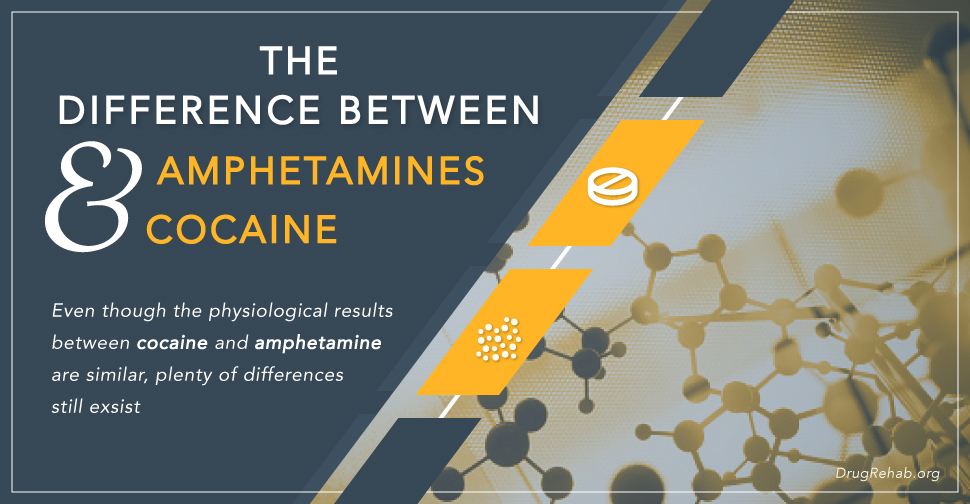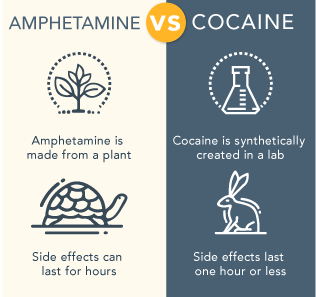
One of the most seen and known childhood neurodevelopmental disorders is attention deficit hyperactivity disorder or ADHD. This disorder can continue all the way through teen years and into adulthood. What most reach for when dealing with this type of disorder is a stimulant medication. Surveys are finding that the abuse of prescription stimulants has been increasing. Stimulants, both illicit and prescribed, have several notable effects, including: creating a more alert state, increasing attention; and raising blood pressure, breathing, and heart rate. There are different types of stimulants which are commonly abused, and two of them are amphetamines and cocaine.
Amphetamine Abuse
Much like cocaine, there are many ways to use and abuse amphetamines. They can be taken orally, snorted, smoked, or injected. When this drug is put into the body, the neurotransmitters dopamine and norepinephrine are activated from the nerve endings in the brain and their reuptake is constrained. Amphetamines cause a buildup of neurotransmitters at synapses within the brain. This creates a sharp mental focus, a state of wakefulness, and increased concentration—elements which normally aid those who have ADHD. Amphetamines are often mixed with other drugs or alcohol, making the effects even more intensified.
Commonly abused amphetamines include:
- Adderall (mixed amphetamine salts)
- Vyvanse
- Dexedrine (dextroamphetamine)
- Desoxyn (prescription methamphetamine)
- Crystal Methamphetamine
Are you or a loved one suffering from addiction?
Don't wait, get the best treatment options today
Call Now: (833) 473-4227The Effects of Amphetamine Use
Amphetamines are used for a number of medical disorders, and when used illicitly, may cause a variety of uncomfortable, and even dangerous, side effects. As referenced from the Center for Substance Abuse Research, these include:
Medical applications of amphetamines:
- Narcolepsy (uncontrolled episodes of sleep)
- Parkinson’s disease
- Obesity
- Attention deficit hyperactivity disorder
Short-term effects of amphetamine use:
- Increased body temperature and blood pressure
- Exhibiting hostile or paranoid behaviors
- Becoming increasingly active or talkative
- Becoming less tired or lethargic
- Dilated pupils
- Cardiovascular system failure
- Intense feelings of well-being or euphoria
- Erratic or increased heart rate
- Dry mouth
- Becoming more alert or energetic
- Increased respiratory rate
- Nausea or suppressed appetite
- Headache
- Heart palpitations
- Decreased inhibitions in social settings
- Uncontrollable movement of muscles within your extremities
- Changes to sexual conduct
- Feeling overly powerful, clever, or competent without cause
Long-term effects of amphetamine use:
- Toxic psychosis
- Dizziness or trouble breathing
- Excessive fatigue or weakness
- Physiological, behavioral, or mental disorders
- Malnourishment or becoming deficient in certain vitamins
- Alterations to a person’s mood or mental state
- Repetitive motor activity
- Cardiac arrhythmias or pounding heartbeat
- Ulcers
- Skin becomes pale or flushed
- Skin conditions
- Impaired coordination and physical collapse
- Abuse or addiction
- Convulsions, coma, and death
Attention deficit hyperactivity disorder has been seen and detected in two to four million children. With this disorder on the rise, and also affecting adults, amphetamines are being prescribed more and more. If the doctor’s instructions are followed the way they’re supposed to be, this drug can help improve the health of these individuals. The temptation for drug abuse and potential for addiction is far lower when these prescriptions are taken orally and in the way they are prescribed.

When an individual uses amphetamines in a binge-like fashion, that is, in increasing amounts and frequencies, there is a much higher risk of abuse or addiction. An amphetamine binge can leave an individual with several negative effects such as: depression, anxiety, intense exhaustion, and an urge to use more of this drug. The person may also experience violent and erratic behavior, which may lead to other types of psychosis as well. Much like schizophrenia, paranoia or other forms of hallucinations may start to occur.
What is Cocaine?
Cocaine comes from a South American plant called the Erythroxylon coca. Within this region, the natives of the Andes would take the leaves of this plant and chew them for an energized feeling. When this was discovered, cocaine was created, offering a much more potent impact than chewing the leaves offered. This was quickly discovered by the medical world. This drug soon became widespread, and companies started to use it at a rapid rate in their products. People soon got addicted to these products because of the cocaine in them.
comes from a South American plant called the Erythroxylon coca. Within this region, the natives of the Andes would take the leaves of this plant and chew them for an energized feeling. When this was discovered, cocaine was created, offering a much more potent impact than chewing the leaves offered. This was quickly discovered by the medical world. This drug soon became widespread, and companies started to use it at a rapid rate in their products. People soon got addicted to these products because of the cocaine in them.
In some cases, cocaine has been used for medical purposes, but for the most part it is an illegal substance in the United States. An upper-class form of cocaine is the pure white powder, and the freebase, crystal form known as “crack” is less expensive and is a variety of colors from light brown to white.
The Difference Between Amphetamines and Cocaine
Growing in the Andes mountains, cocaine is naturally derived from the coca plant. Amphetamines, on the other hand, are similar to ephedrine and are synthetically made. Both of these drugs are offered, and used, in numerous forms, and each form has its differences.
 Cocaine and amphetamines have very similar effects on the brain and normally attract similar people who abuse each. Cocaine and amphetamines both increase the circulating levels of certain neurotransmitters within the brain. Dopamine, norepinephrine, and serotonin are stimulated and increased in activity when amphetamines are used. Cocaine blocks the reuptake of certain neurotransmitters, notably dopamine, causing the levels to rise. Even though the physiological results between cocaine and amphetamine are nearly mirrored, the impact of amphetamine may be felt for several hours, whereas cocaine’s effects are usually present for an hour or less.
Cocaine and amphetamines have very similar effects on the brain and normally attract similar people who abuse each. Cocaine and amphetamines both increase the circulating levels of certain neurotransmitters within the brain. Dopamine, norepinephrine, and serotonin are stimulated and increased in activity when amphetamines are used. Cocaine blocks the reuptake of certain neurotransmitters, notably dopamine, causing the levels to rise. Even though the physiological results between cocaine and amphetamine are nearly mirrored, the impact of amphetamine may be felt for several hours, whereas cocaine’s effects are usually present for an hour or less.
Historically, both drugs had their applications. Cocaine was isolated from coca leaves and began to be used as an anesthetic. Sigmund Freud recommended cocaine’s power in aiding with depression and morphine dependence; however, once he understood the side effects, he no longer promoted the drug. Amphetamines were used to help soldiers in World War II overcome fatigue.
In conclusion, both of these drugs have similar effects on the brain and body, but unlike cocaine, amphetamines are frequently prescribed in medical applications to help aid ADHD and other disorders.
Find The Help You Need Today
If you or a loved one is suffering from drug abuse or addiction from either of these drugs, we are here to help you find a way out. Please contact us today at DrugRehab.org. A release of too much dopamine in the brain from either of these drugs may lead to other problems, including, at times, permanent brain damage. Please reach out today.
For More Information Related to “The Difference Between Amphetamines And Cocaine” Be Sure To Check Out These Additional Resources From DrugRehab.org:
- What is “Freebase Cocaine”?
- Common Street Names For Illegal Drugs
- How Long Does Cocaine Stay In Your System?
- Types of Addictions: Cocaine
- Cocaine And Alcohol: A Deadly Combination
- How Much Does a Drug and/or Alcohol Intervention Cost?
- Is Cocaine Physically Addictive? Is It Mentally Addictive?
- Cocaine Use And Depression
- Understanding Cocaine’s Effect On The Brain
Sources
Center for Substance Abuse Research — Amphetamines
Dartmouth Undergraduate Journal of Science — Psychostimulants: Cocaine for Toothaches and Amphetamines for All-nighters


